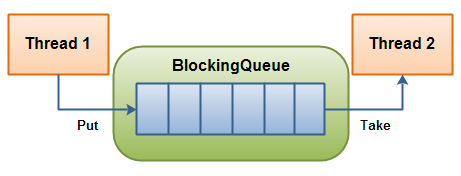阻塞队列与普通队列的区别在于,当队列是空的时,从队列中获取元素的操作将会被阻塞,或者当队列是满时,往队列里添加元素的操作会被阻塞。试图从空的阻塞队列中获取元素的线程将会被阻塞,直到其他的线程往空的队列插入新的元素。同样,试图往已满的阻塞队列中添加新元素的线程同样也会被阻塞,直到其他的线程使队列重新变得空闲起来,如从队列中移除一个或者多个元素,或者完全清空队列,下图展示了如何通过阻塞队列来合作:

线程1往阻塞队列中添加元素,而线程2从阻塞队列中移除元素
从5.0开始,JDK在java.util.concurrent包里提供了阻塞队列的官方实现。尽管JDK中已经包含了阻塞队列的官方实现,但是熟悉其背后的原理还是很有帮助的。
阻塞队列的实现方式1
使用传统的wait,notifyall方式实现
import java.util.LinkedList; import java.util.List; public class BlockingQueue { private List list = new LinkedList(); private int limit = 10; private static BlockingQueue queue = new BlockingQueue(); public synchronized void enqueue(Object item) throws InterruptedException { while (list.size() == limit) { wait(); } this.list.add(item); notifyAll(); } public synchronized void dequeue() throws InterruptedException { if (this.list.size() == 0) { wait(); } this.list.remove(0); notifyAll(); } }
阻塞队列的实现方式2
使用传统的ReentrantLock方式实现
import java.util.concurrent.locks.Condition; import java.util.concurrent.locks.Lock; import java.util.concurrent.locks.ReentrantLock; class BoundedBuffer{ final Lock lock = new ReentrantLock(); final Condition notFull = lock.newCondition(); final Condition notEmpty = lock.newCondition(); final Object[] items = new Object[100]; int putptr, takeptr, count; public void put(Object x) throws InterruptedException{ lock.lock(); try{ while (count == items.length){ notFull.await(); } items[putptr] = x; if(++putptr == items.length){ putptr = 0; } ++count; notEmpty.signal(); } finally{ lock.unlock(); } } public Object take() throws InterruptedException{ lock.lock(); try{ while (count == 0){ notEmpty.await(); } Object x = items[takeptr]; if(++takeptr == items.length){ takeptr = 0; } --count; notFull.signal(); return x; } finally{ lock.unlock(); } } }